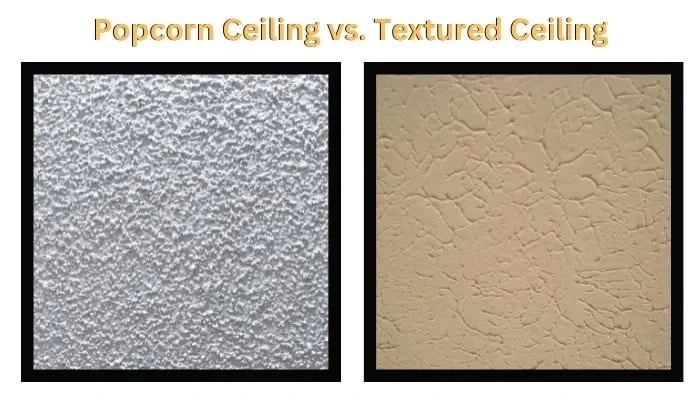When renovating your home, selecting the right ceiling design is crucial. Two popular options are popcorn ceilings and textured ceilings. What distinguishes them? This article will delve into the differences between popcorn ceilings vs textured ceilings.
Despite their similar appearances, popcorn and textured ceilings have notable differences. Popcorn ceilings are created by spraying a mixture of paint and acoustic materials, like Styrofoam beads or vermiculite, onto the ceiling. This type of ceiling was common in homes built before 1980 due to its affordability and soundproofing qualities.
Textured ceilings, on the other hand, are made by spreading a thick drywall joint compound on the ceiling using tools such as trowels and brushes. The look of textured ceilings can vary greatly depending on the technique used, including orange peel, knockdown, swirl patterns, combed streaks, and stippling.
Maintenance for popcorn and textured ceilings differs. Popcorn ceilings are generally more durable but may need re-spraying if stained. Textured ceilings, with their intricate patterns, are harder to clean, often requiring professional assistance to remove dirt and dust effectively.
Ultimately, the choice between a popcorn ceiling and a textured ceiling hinges on your personal style, budget, and maintenance preferences.
What is a Popcorn Ceiling?
A popcorn ceiling, also known as a “cottage cheese ceiling” or acoustic ceiling, is created by spraying a textured compound onto the surface. This results in a distinctive bumpy and pitted appearance.
This process involves using a hopper gun or trowel to apply wet joint compound to a drywall surface. Once applied, the compound hardens into small bumps, forming a unique pattern on the ceiling. For best results, professionals recommend installing this type of texture.
Popcorn ceilings were prevalent in homes built before 1980 to hide flaws in the walls, such as nail holes and seams. Some homeowners still prefer popcorn ceilings for their sound-reducing qualities and noise insulation in multi-level homes. Popcorn ceilings offer a cost-effective and quick way to renovate a room without significant expense or time investment.
Benefits of a Popcorn Ceiling
Popcorn ceilings add character to a room while providing sound insulation and noise reduction. They were widely used in homes built before 1980 due to their affordability and ability to hide flaws.
For those seeking a more contemporary look, smooth ceilings or stipple ceilings might be preferable. Stipple ceilings, created by spreading joint compound on drywall with a brush or trowel, have larger bumps than popcorn ceilings, making them easier to clean and giving a modern feel to any space.
A skim coat is another popular choice for those desiring a very smooth finish. This method involves applying many thin layers of joint compound to the ceiling until it is smooth. Skim coating takes longer than popcorn or stipple textures, but homeowners choose it for its better water damage protection and longer-lasting results.
Before starting your project, consult professionals to choose between popcorn textures, stipple ceilings, or a skim coat. This ensures a smooth process and desired results.
Disadvantages of a Popcorn Ceiling
Despite the benefits, popcorn ceilings have some drawbacks to consider before installation. One major issue is that old popcorn ceilings may contain asbestos, which can become airborne if the material is disturbed.
Asbestos is hazardous to health, potentially causing lung cancer and mesothelioma. Prolonged exposure increases the risk of developing these conditions.
To protect your health, avoid contact with asbestos. Homeowners must take precautions when cleaning or repairing popcorn ceilings to prevent releasing harmful particles into the air.
Additionally, popcorn ceilings can trap dust and allergens, worsening symptoms for those with allergies. People sensitive to dust may experience asthma problems when it accumulates.
Fortunately, newer versions of popcorn textures use safer materials that do not contain asbestos. Before selecting a ceiling texture, verify with your local building authority to ensure it meets safety standards.
What is a Textured Ceiling?
Textured ceilings are an excellent alternative to popcorn ceilings, offering numerous benefits that set them apart. They are more visually appealing and can transform a room with minimal effort. Textured ceilings look smoother and more modern, creating the illusion of a larger space and giving a fresh, updated appearance.
Textured ceilings are also safer for health, as they do not contain asbestos, unlike many older popcorn ceilings. Different textures can effectively hide imperfections on ceilings, depending on the type chosen.
Textured surfaces can conceal small cracks or holes without needing extensive drywall replacement, saving both time and money.
Benefits of a Textured Ceiling
Textured ceilings offer aesthetic and practical advantages. They are easier to install than drywall or knockdown ceiling styles. Instead of applying the compound in small sections, you can use special textured paint to cover the entire ceiling at once, making the process fast and efficient.
Textured ceilings are ideal for DIY enthusiasts who want to save time on their projects. They are also great for creating interesting visual effects in any space. You can choose from simple wood chip paper or bold swirls and circles to customize your room without significant expense. The options are endless for making your space unique. If you ever decide to redecorate, you can easily repaint over the existing texture with minimal effort.
Textured ceilings are becoming increasingly popular due to their ability to mask imperfections, make rooms appear larger, and allow for visually striking designs. With so much to offer, it’s no wonder they remain a favorite among homeowners. For the best results, hire a professional contractor to complete your project correctly.
Disadvantages of a Textured Ceiling
One significant issue with textured ceilings is that they can be difficult to repair. Fixing imperfections on a textured surface is harder than on a smooth one like drywall, often requiring more effort. Sanding down the area before applying the compound and matching the texture with the rest of the ceiling can be challenging. Consequently, many homeowners opt to replace their ceilings entirely if there is significant damage rather than attempt repairs.
Your style is another consideration when deciding between popcorn and textured ceilings. Popcorn-style surfaces have a classic appearance and can hide wall imperfections, while textured finishes offer more visual variety but may not suit everyone’s taste. Therefore, it’s essential to decide which style best fits your space before committing.
Final Thoughts
Popcorn ceilings and textured ceilings are popular choices for homes. Classic popcorn ceilings may contain asbestos, requiring professional removal. In contrast, textured ceilings are safer and offer a unique aesthetic. Considering the differences between these two ceiling types before making a choice is essential.
According to the National Association of Home Builders (NAHB), over 70% of new homes in 2019 had textured walls or ceilings. This indicates a growing trend in using textured surfaces over plain, flat finishes like popcorn ceilings. Many people prefer texture for their indoor spaces.
When deciding between popcorn and textured ceilings, consider the pros and cons based on your preferences. Choose between classic or modern styles, but research health risks before deciding. Be confident and informed about your choice.
If you are looking for popcorn ceiling removal services, consider hiring ROA Drywall for professional assistance. Textured ceilings are a safer and more modern alternative to smooth ceilings, typically free from asbestos. They also offer a unique aesthetic, making them a popular choice among homeowners.



